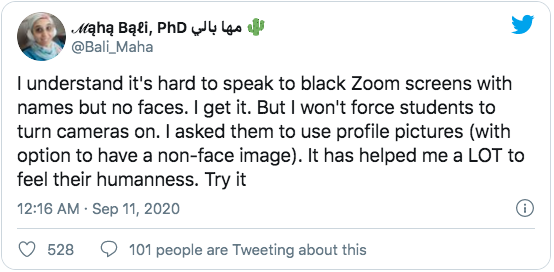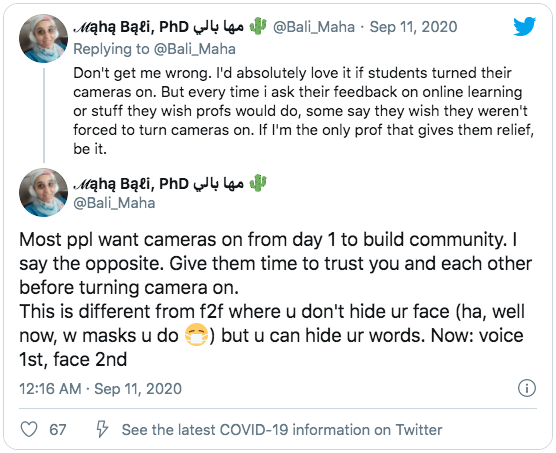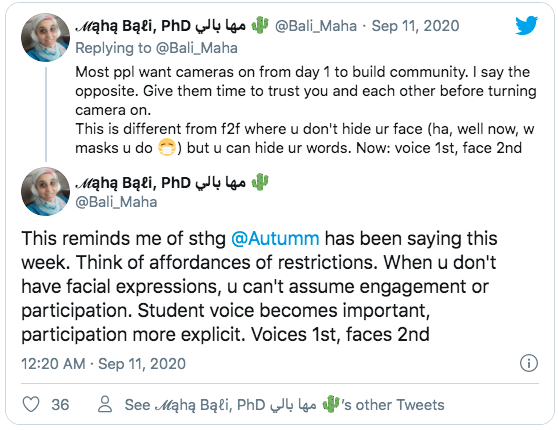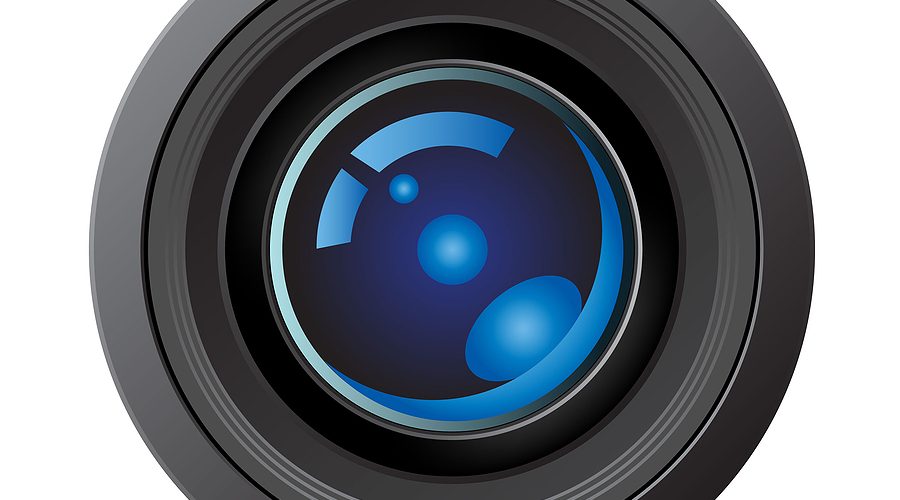In a moment of empathy with a lot of faculty/teachers in these times, I wrote this tweet:

Everyone knows my stance on cameras on or off. we should not force students to turn them on, because there are many good reasons why they might want them off. But more importantly, we need to interrogate our own reasons for wanting them on, right? I get the emotional craving, I do.
For me, this semester, I do have a hunger to know what my students look like. If we were in person, I would not see their faces because of masks. Since we’re not in person, Zoom seems like the place to see their faces. But honestly, profile pics really help a lot. If they have connectivity issues, their video will be wonky anyway, and I would not be able to hear their voices clearly. Hence, voices first, faces second.
I get frustrated when faculty tell me they asked students to turn the camera on and students did it. Like they are telling me “so there, turns out they will do it” and they are not realize they’ve just coerced them to do it. I surveyed my students on whether they prefer having camera on or off. I don’t have permission from them to share (did not get IRB) but will ask them if it’s OK to share the chart that came out. But in summary of 17 students who responded: not a single student said they PREFER the camera on; a small minority don’t care either way and will do what the prof asks or follow the crowd. But the majority either keep it off for connectivity reasons, because they are more comfortable with the camera off, or because they are not always camera ready (or any combination of these). On average, students had 2.6 reasons for wanting the camera off. That’s 2-3 reasons why each person prefers to have it off, people. Not just one. I hope I have not violated IRB already.

If you see their faces, it may dupe you into thinking you know that they are engaged. It doesn’t do that. Not online, not in the way it can do face to face (and even then, only sometimes! Only in small classes, only if you are very perceptive and able to read all the students all the time which… really? I do this sometimes for some students but not all the time for all of them)

Think about what Autumn (@autumm) has been saying about affordances of some restrictions like camera off. Do you focus better on what someone is saying when you can’t see them? When you can’t get an impression based on their race or their hairstyle or their tattoos or their clothes? These things can *distract* you from what they have to say, you realize this, right? These things can even bias you, unconsciously, about them.
In a convo with Alan Levine (@cogdog) and Sherri Spelic (@edifiedlistener) around this Twitter thread, I came up with an idea. To use “structured dialogue” (a technique of Sherri’s) and help students use their imaginations (something Alan tweeted) and ask them to interview each other about some things, and then explicitly make assumptions about each other… as a way to talk about bias and empathy and the ways we assume things about people when we have a small amount of information about them (and maybe when we don’t see them even). We could even RENAME ourselves for this activity so that people don’t know who is with them in the room altogether. Imagine doing it in TEXT so we can’t hear if it is a male or female voice, even. Possibilities are endless here!
And I still get everyone’s emotional need to see faces. It’s only human. Especially if you go out and see lots of masks (not the case everywhere in Egypt, but I guess elsewhere in the world)
Editor’s note: This article is an abridged version of one of Maha’s recent posts. You can read the full post here along with lots of other insights and helpful suggestions including this post with other ideas to make sure your students are engaged . We are delighted to have Maha as one of our speakers at the next Media & Learning Online event on 18 November.















